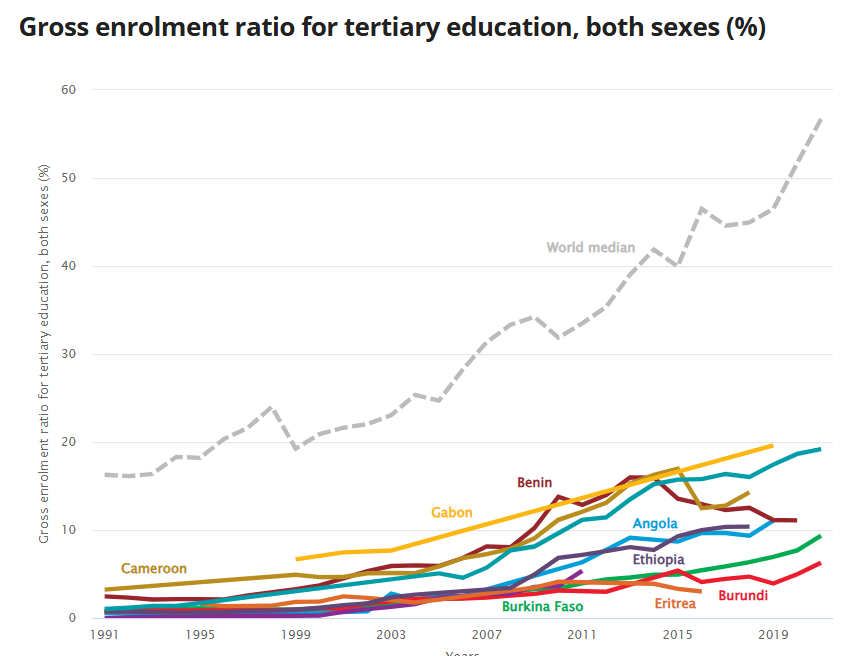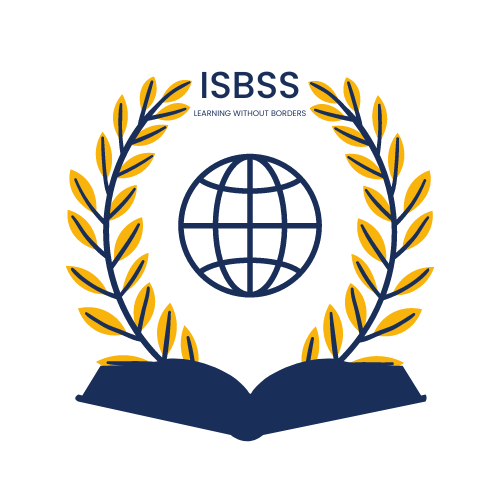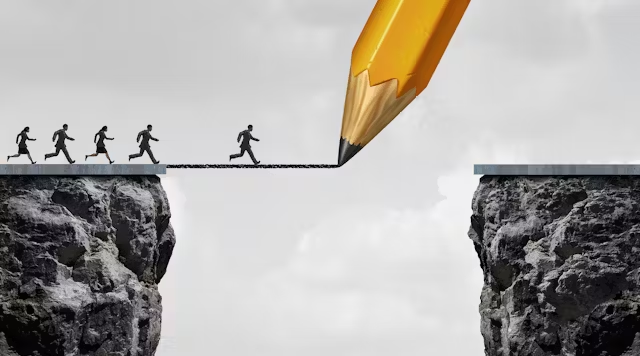
The State of the Crisis: Why Millions Are Locked Out of Quality Education.
Introduction
Education is a key driver of economic growth, social mobility, and poverty reduction. As the World Bank states, “Tertiary education provides unique opportunities for individual development and equality of opportunity as well as promoting shared prosperity” (World Bank 2020). Yet, systemic barriers such as inadequate infrastructure, financial constraints, and the digital divide exclude millions from quality education, particularly in West Africa, Southeast Asia, and parts of Europe. This global crisis demands immediate intervention.
The International School of Business, Social Science, and Technology (ISBSS) aims to bridge this gap by offering accessible, high-quality online education tailored to underserved communities. This article examines the scale of the crisis, its human impact, and the role education plays in global development, positioning ISBSS as a key part of the solution.
The Scale of the Problem
Stark Enrollment and Graduation Gaps
Access to higher education in developing regions remains disproportionately low. According to UNESCO (2023):
- West Africa has a tertiary education enrollment rate of just 8–12%, leaving millions without access to advanced learning opportunities. Although this rate doubled between 2000 and 2010, it remains significantly lower than in other regions. It is half the rate in Central and Southern Asia in 2000 and 2010, and three times lower than in the same region in 2022, indicating that the gap between Africa and the rest of the world is widening.
- Southeast Asia shows higher enrollment rates at 25–35%, outperforming Sub-Saharan Africa and Central Southern Asia, but still trailing behind North America, Europe, and Oceania. Disparities between urban and rural areas further exacerbate this issue.
- In parts of Eastern and rural Europe, tertiary enrollment rates range from 45–60%, highlighting substantial regional inequalities even within developed regions.


In contrast, developed countries often boast tertiary education enrollment rates above 75%. For instance, OECD countries had a rate of 89.79% in 2020, with a rate of 100% in countries like Lithuania and Portugal, and between 96.57% and 98.44% in countries like France, Japan, Slovenia, Sweden, Finland and Belgium). The rate for the United State was 92.42% that same year. UNESCO data (See charts 1, 2 and 3) clearly shows that Sub-Saharan Africa and Central and Southern Asia continue to lag behind the rest of the world in higher education enrollment. However, disparities persist even within African countries, as reflected in regional comparisons
1.2 Infrastructure and Resource Deficiencies
Inadequate infrastructure significantly hinders access to education:
- West Africa faces severe shortages of qualified teachers, modern classrooms, and updated learning materials. Overcrowded lecture halls exacerbate the problem, with many universities following a “first-come, first-seated” approach due to limited space. A critical issue is the lack—or complete absence—of digital infrastructure in Sub-Saharan countries.

- Southeast Asia struggles with aging school buildings, overcrowded classrooms, and limited digital infrastructure, especially in rural regions.
- Eastern Europe suffers from declining investment in rural education, leading to outdated facilities and teacher shortages.
The student-to-teacher ratio across Africa is considerably higher than global standards, often exceeding 20 students per teacher. In Ghana, for example, the ratio varies between 33:1 in the sciences and 49:1 in social sciences and humanities, compared to recommended ratios of 18:1 and 27:1, respectively. These challenges disproportionately affect rural and marginalized communities, limiting both access to and the quality of education.
1.3 The Widening Digital Divide
The digital divide deepens educational disparities as digital literacy becomes increasingly vital. According to the World Bank (2022), only 28% of households in Sub-Saharan Africa have internet access, while Southeast Asia averages 55%, with stark rural-urban gaps. In contrast, over 90% of households in developed nations enjoy reliable connectivity. Limited internet access, high data costs, and scarce digital devices prevent millions from benefiting from modern educational resources.
1.4 Financial Barriers
Financial barriers remain one of the biggest obstacles to higher education access in developing regions, disproportionately affecting students from low-income families. Many struggle to afford not only tuition but also transportation, housing, and essential learning materials. Even when universities offer scholarships, they are often limited and highly competitive, leaving many students without viable options.
Government underfunding exacerbates the issue. In many West African countries, for example, governments allocate only **3–4%** of their GDP to education, well below UNESCO’s recommended **6%**, resulting in outdated facilities, underpaid educators, and limited financial aid programs. In contrast, wealthier nations invest significantly more, creating a stark gap in educational opportunities. Additionally, many developing countries lack strong student loan systems, making it difficult for students to finance their education without plunging into debt.
The financial strain forces many students to abandon their studies or take on multiple jobs, negatively impacting academic performance. Others resort to informal or lower-quality educational alternatives, limiting their career prospects and economic mobility. Without substantial investment and financial aid expansion, millions will remain locked out of higher education, perpetuating cycles of poverty and inequality.
Human Impact: Stories Beyond Statistics
Behind these statistics are countless stories of lost potential and unfulfilled dreams.
Fatoumata, a gifted student from Guinea, dreamed of becoming a civil engineer. Despite excelling academically, she was unable to attend university due to the scarcity of engineering programs and her family’s financial struggles. Today, she works in informal labor, unable to contribute to her country’s infrastructure development.
In rural Indonesia, Rizal walked two hours daily to attend an under-resourced school. His ambition to study computer science was cut short because his family could not afford university tuition or relocation costs. Without access to higher education, his dream remains unrealized.
Elena, from rural Romania, aspired to study environmental science. The nearest university offering her desired program was hundreds of miles away, and scholarships were scarce. She was forced to abandon her studies to support her family, leaving her community without a future environmental advocate.



Framing the Stakes: Why Education Matters
A Catalyst for Economic Development
Education drives economic growth by building a skilled workforce that fosters innovation, productivity, and high income. The World Bank (2023) estimates that each additional year of schooling increases earnings by 10%. Regions with higher education enrollment consistently achieve stronger economic performance. In West Africa, industries struggle due to a lack of skilled labor, slowing economic diversification. Similarly, Southeast Asia’s growth is hindered by skills gaps in technology and industrial sectors.
Promoting Social Equity and Inclusion
Education is a powerful tool for reducing poverty and inequality. UNESCO (2023) notes that individuals with higher education are 60% less likely to live in poverty. Women and marginalized groups particularly benefit from access to education, breaking generational cycles of poverty.
Enhancing Global Competitiveness
Countries that underinvest in education risk falling behind in global competitiveness. In today’s digital economy, a tech-savvy, innovative workforce is vital. Developing nations must seize the opportunity to build a globally competitive labor force, similar to India’s success in supplying skilled online labor to Western companies.
ISBSS: Bridging the Education Gap
The International School of Business and Social Sciences (ISBSS) is committed to assist in dismantling educational barriers by providing accessible, affordable, and high-quality online learning through:
- Flexible and Inclusive Learning Models: Fully online programs can significantly reduce costs and eliminate geographical barriers, enabling students to balance education with other life commitments.
- Culturally Relevant Curricula: Programs tailored to local market needs ensure that students acquire practical, industry-aligned skills that are relevant to their environments.
- Technological Innovation: The use of low-bandwidth solutions and mobile-friendly platforms makes education accessible even in areas with limited connectivity, bridging the digital divide.
- Financial Accessibility: Affordable programs, combined with need-based scholarships and flexible payment options, can make education attainable for underserved populations.
. Together, these resolutions represent a collaborative effort toward building more inclusive and equitable educational systems worldwide.
A Call to Action
The global education crisis requires immediate, coordinated action. Governments, policymakers, and educational institutions must prioritize accessible, quality education. With global trends like automation, climate change, and digitalization reshaping the workforce, developing countries—especially in Africa—must urgently reform education to equip the next generation. The World Bank warns that when tertiary education systems fail to remain effective, societies risk significant social unrest. Young people who are excluded from the education system struggle to engage in meaningful learning and face uncertainty about their educational and career futures. This disengagement creates a serious challenge for societies, which are left without the skilled graduates essential for maintaining social stability and driving economic growth.
Conclusion
The educational divide is a global crisis restricting human potential and slowing economic growth. Millions are denied opportunities to contribute meaningfully to society due to systemic barriers. The International School of Business and Social Sciences (ISBSS) is dedicated to contributing in transforming this reality through inclusive, high-quality education.
The time to act is now. Together, we can break down educational barriers and unlock the potential of millions worldwide.



